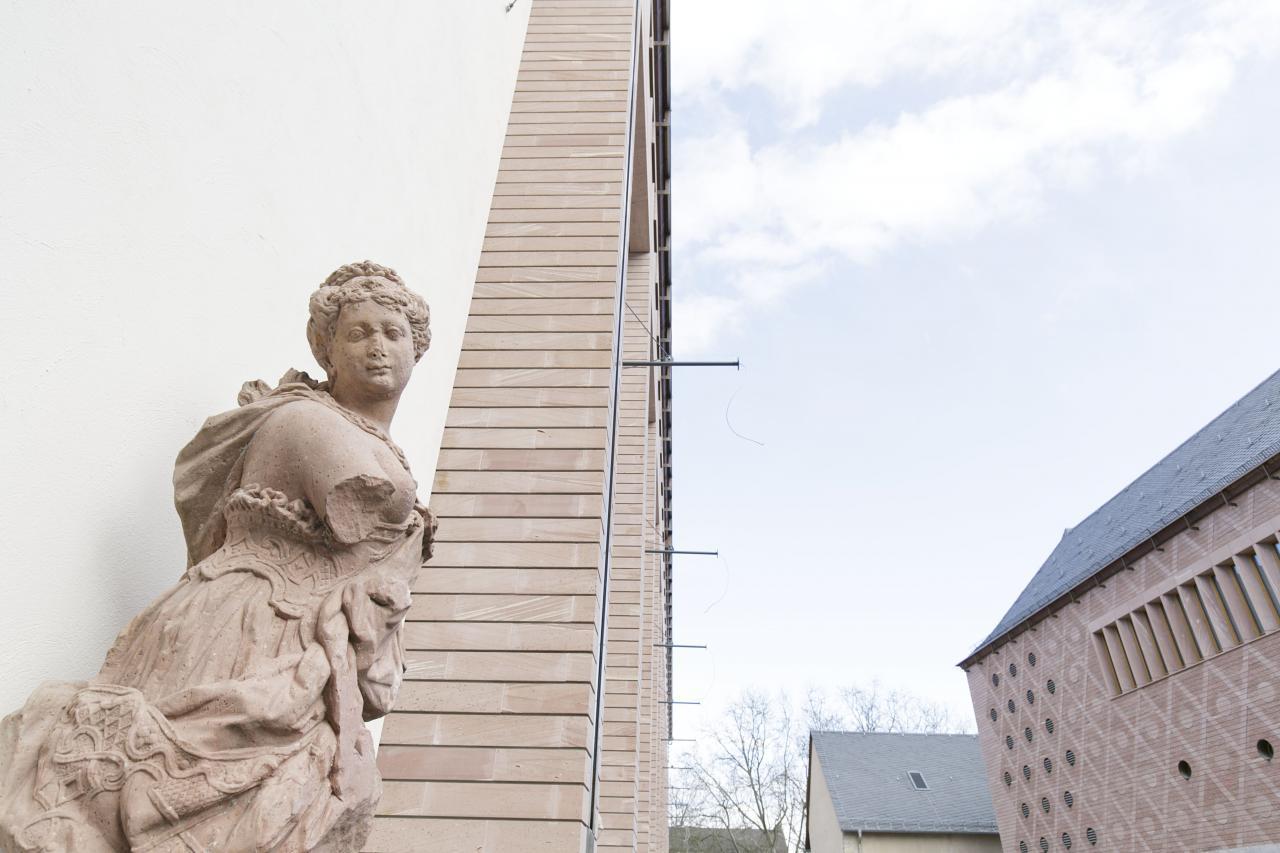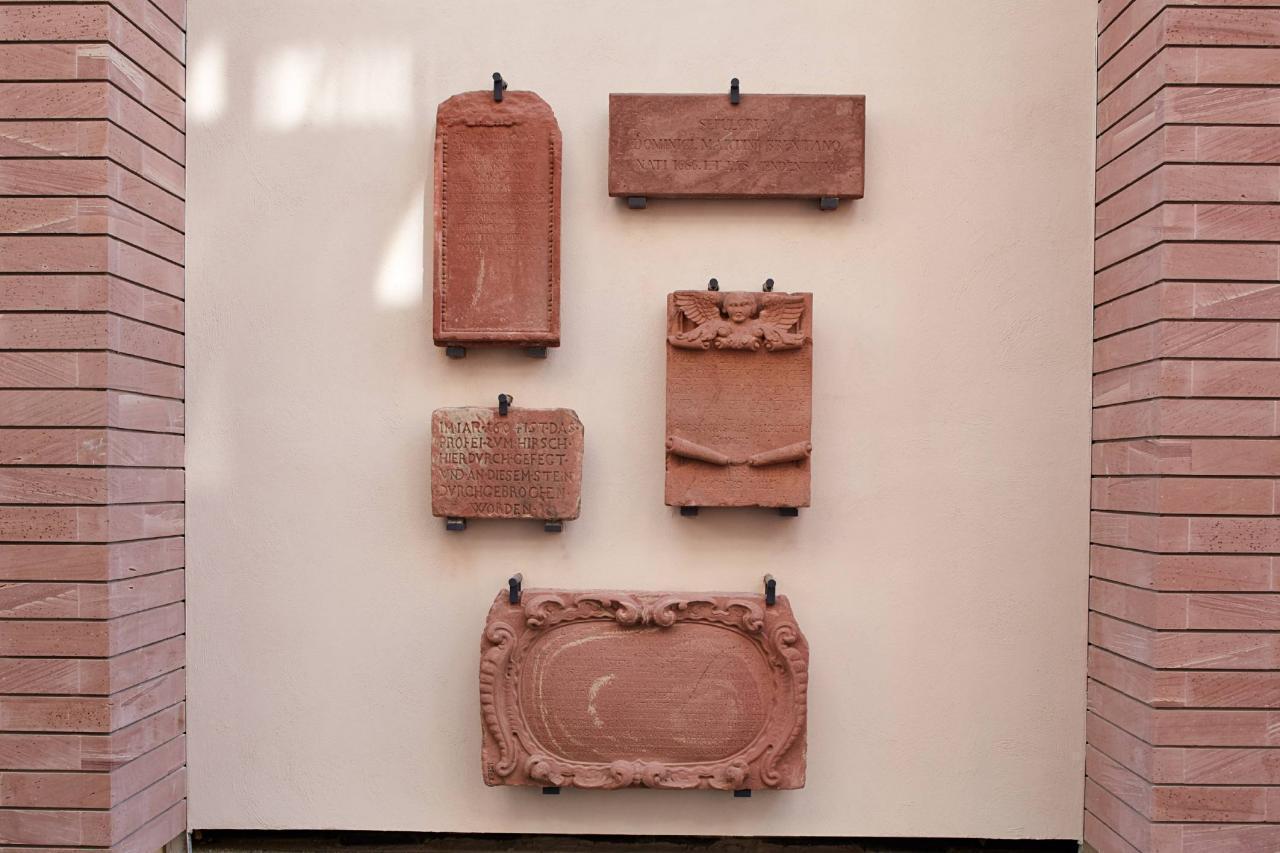The sculpture gallery at Museumsplatz
The facade of the exhibition building is divided by twelve alcoves on the Museumsplatz side. Figure sculptures from Frankfurt gardens dating from the 17th to 19th centuries are presented here.
In installing them, great care was taken to align the visual axes. Passers-by therefore encounter sculpture and dramatic art on the staircase, whilst Pluto, the god of the underworld, looks over those walking from the west from Saalgasse. According to the provenance from various gardens, the allegories, gods and stone vases are organised in groups.
Group 1
In the West, the series starts with three female depictions of the beautiful coast, which moved from their green refuge in Rödelheim an die Zeil, then to Forsthausstraße and, finally, were stored in a garden in the ramparts before being moved to the Historisches Museum in 1955.
Provenance (not certain): Garden of Detmar Friedrich Wilhelm Basse, merchant and politician (1764-1836), in Rödelheimfrom 1808: Garden of Georg Brentano in Rödelheim
before 1875: Garden of the Palais Mumm an der Zeil 36
from approx. 1904: Garden of the Villa Mumm an der Forsthausstraße
from 1938: Du Fayscher garden in the ramparts (Schweizerhäuschen), Neue Mainzer Straße
1955 Transfer to the Historisches Museum by the Gartenamt
Group 2
The muscular figure of Hercules placed in the centre of the gallery once marked the start of a boulevard in the garden of the Mayor of Frankfurt, Johannes Schwind (1580-1648), as shown in a coloured engraving by Mathias Merian Senior of Friedberger Straße 164. It was damaged and the head was lost.
Provenance: Garden of Johannes Schwind (1580-1648), merchant, juror and younger mayor, on Friedberger Gasse– 1648 inherited by his nephews Johann Thomas and Johann Hieronymus Eberhard
– in the courtyard at Hirschgraben 11 until 1945
– salvaged during rubble clearance in 1955 and transferred to the Historisches Museum
Group 3
The figure of the goddess Flora contributed to the Arcadian atmosphere in the garden of the wine merchant Konrad Valentin Reineck (1657-1721). It has been owned by the city since 1822 and, in 1878 when the Stadtpalais was demolished, it was moved to the Historisches Museum.
Provenance: Garden of the Stadtpalais of the wine merchant Konrad Valentin von Reineck (1657-1721) - owned by the city since 1822 - after the demolition of the Stadtpalais in 1878, moved from the construction yard of the city to the Historisches Museum in 1879
Group 4
The author and Preußische Rat, Johann Michael von Loën (1694-1776), and the construction entrepreneur and Preußische Baurat, Philipp Holzmann (1836-1904) created a special atmosphere in their gardens with depictions of ancient gods such as Minerva, Juno, Diana and Pluto. These include the group of four allegories that were created by the sculptor Cornelius Andreas Donett (1682-1748).
Provenance: (not proven:) from 1713 garden of the architect Johann Friedrich Eosander von Göthe (1669-1728) before the Gallus gate “An der Windmühle” (now Untermainkai 70)- from 1721 garden of Johann Michael von Loën (1694-1776), author and Preußischer Wirklicher Geheimer Rat
- from 1880 garden of the construction entrepreneur and Königlich Preußischer Baurat Philipp Holzmann (1836-1904)
- acquired for the Historisches Museum in 1930 and 1956



